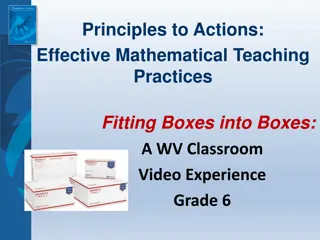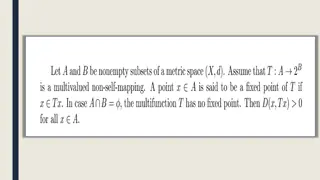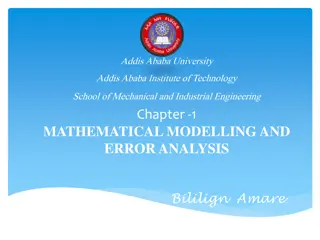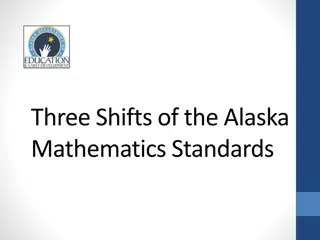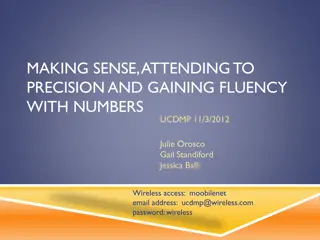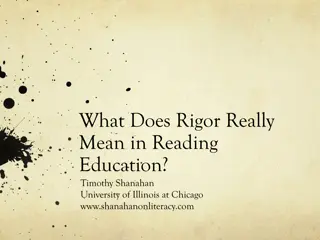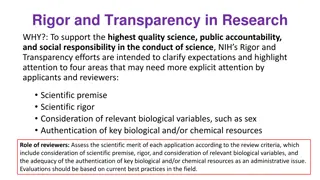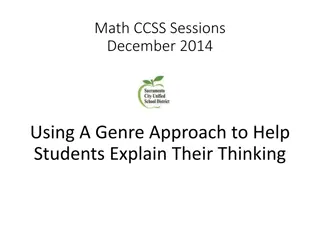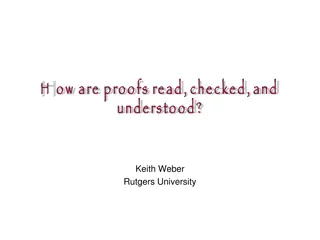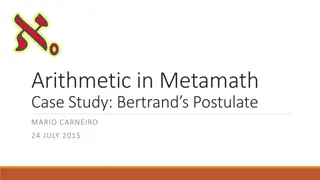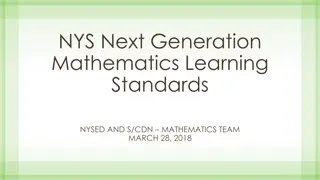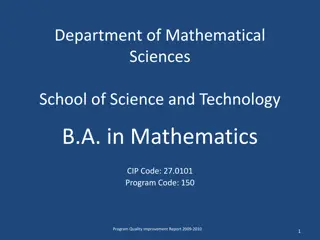Mathematical Rigor in Pre-K-5 Standards Analysis
Explore the three aspects of Mathematical Rigor - Conceptual Understanding, Procedural Fluency, and Application Capacity in analyzing content standards for grades Pre-K to 5. Dive into examples, standard analysis, and real-world application opportunities provided by the Massachusetts Department of Elementary and Secondary Education.
Download Presentation

Please find below an Image/Link to download the presentation.
The content on the website is provided AS IS for your information and personal use only. It may not be sold, licensed, or shared on other websites without obtaining consent from the author.If you encounter any issues during the download, it is possible that the publisher has removed the file from their server.
You are allowed to download the files provided on this website for personal or commercial use, subject to the condition that they are used lawfully. All files are the property of their respective owners.
The content on the website is provided AS IS for your information and personal use only. It may not be sold, licensed, or shared on other websites without obtaining consent from the author.
E N D
Presentation Transcript
Curriculum Frameworks Key Shifts: Mathematical Rigor in Pre-K 5 Standard Analysis Protocol
Session Objective For participants to be able to analyze content standards using the three aspects of Mathematical Rigor (Conceptual Understanding, Procedural Fluency, and Application (Capacity)). 2 Massachusetts Department of Elementary and Secondary Education
01 Mathematical Rigor 02 Grade 3 Example Agenda 03 Grade 2 Example 04 Grade 1 Example
01 Mathematical Rigor
Mathematical Rigor Massachusetts Department of Elementary and Secondary Education 5
Item 2 Grade 3 Example 02 Grade 3 Example
Standard Analysis 3.MD.C.5 - Recognize area as an attribute of plane figures and understand concepts of area measurement. a. A square with side length 1 unit, called a unit square, is said to have one square unit of area, and can be used to measure area. b. A plane figure which can be covered without gaps or overlaps by n unit squares is said to have an area of n square units. What Conceptual Understanding does this standard describe? What Procedural Fluency does this standard describe? What authentic opportunities exist for the Application of this standard to real- world problems? 7 Massachusetts Department of Elementary and Secondary Education
Standard Analysis 3.MD.C.5 - Recognize area as an attribute of plane figures and understand concepts of area measurement. a. A square with side length 1 unit, called a unit square, is said to have one square unit of area, and can be used to measure area. b. A plane figure which can be covered without gaps or overlaps by n unit squares is said to have an area of n square units. What Conceptual Understanding does this standard describe? 8 Massachusetts Department of Elementary and Secondary Education
Standard Analysis 3.MD.C.5 - Recognize area as an attribute of plane figures and understand concepts of area measurement. a. A square with side length 1 unit, called a unit square, is said to have one square unit of area, and can be used to measure area. b. A plane figure which can be covered without gaps or overlaps by n unit squares is said to have an area of n square units. What Procedural Fluency does this standard describe? 9 Massachusetts Department of Elementary and Secondary Education
Standard Analysis 3.MD.C.5 - Recognize area as an attribute of plane figures and understand concepts of area measurement. a. A square with side length 1 unit, called a unit square, is said to have one square unit of area, and can be used to measure area. b. A plane figure which can be covered without gaps or overlaps by n unit squares is said to have an area of n square units. What authentic opportunities exist for the Application of this standard to real- world problems? 10 Massachusetts Department of Elementary and Secondary Education
Conceptual Understanding Students will be able to. Explain why area is measured with squares, like distance is measured with lengths. We use a square because a square is unique its sides are the same length and if the lengths are 1 unit then the area is 1 square unit. Explain why area can be determined by covering a shape with squares, like a distance can be measured by laying down equal lengths next to each other and counting the total. 11 Massachusetts Department of Elementary and Secondary Education
Procedural Fluency Students will be able to. Arrange squares so that the whole shape is covered without gaps or overlaps to measure area. Use/write the term square units when describing area of a shape. Count the squares that cover a shape using groups or other methods to keep track of counting Count using groups and/or multiplication to determine the total. 12 Massachusetts Department of Elementary and Secondary Education
Application Students will be able to. Measure the area of a classroom using square floor tiles. Explain the possible errors a person may make while measuring an area with square tiles. Compare the results of measuring an area with square inches versus square feet. Explain why it is necessary to use the term square units when describing area versus not including units. 13 Massachusetts Department of Elementary and Secondary Education
Item 3 Grade 2 example 03 Grade 2 Example
Standard Analysis Example 1 2.OA.C.3 Determine whether a group of objects (up to 20) has an odd or even number of members, e.g., by pairing objects or counting them by 2s; write an equation to express an even number as a sum of two equal addends. What Conceptual Understanding does this standard describe? What Procedural Fluency does this standard describe? What authentic opportunities exist for the Application of this standard to real-world problems? 15 Massachusetts Department of Elementary and Secondary Education
Standard Analysis Example 1 2.OA.C.3 Determine whether a group of objects (up to 20) has an odd or even number of members, e.g., by pairing objects or counting them by 2s; write an equation to express an even number as a sum of two equal addends. What Conceptual Understanding does this standard describe? 16 Massachusetts Department of Elementary and Secondary Education
Standard Analysis Example 1 2.OA.C.3 Determine whether a group of objects (up to 20) has an odd or even number of members, e.g., by pairing objects or counting them by 2s; write an equation to express an even number as a sum of two equal addends. What Procedural Fluency does this standard describe? 17 Massachusetts Department of Elementary and Secondary Education
Standard Analysis Example 1 2.OA.C.3 Determine whether a group of objects (up to 20) has an odd or even number of members, e.g., by pairing objects or counting them by 2s; write an equation to express an even number as a sum of two equal addends. What authentic opportunities exist for the Application of this standard to real-world problems? 18 Massachusetts Department of Elementary and Secondary Education
Standard Analysis Example 1 2.OA.C.3 Determine whether a group of objects (up to 20) has an odd or even number of members, e.g., by pairing objects or counting them by 2s; write an equation to express an even number as a sum of two equal addends. Create student learning objectives for this standard that describe student learning for each aspect of Rigor: Conceptual Understanding Procedural Fluency Application 19 Massachusetts Department of Elementary and Secondary Education
Grade 1 Example 04 Grade 1 Example
Standard Analysis 1.NBT.C.6 - Subtract multiples of 10 in the range 10 90 from multiples of 10 in the range 10 90 (positive or zero differences), using concrete models or drawings and strategies based on place value, properties of operations, and/or the relationship between addition and subtraction; relate the strategy to a written method and explain the reasoning used. 21 Massachusetts Department of Elementary and Secondary Education
Wrap-up Do we regularly teach to objectives that align to all three aspects of rigor? Are we prioritizing one aspect of rigor over the others? Do we regularly assess students ability to meet objectives that align to all three aspects of rigor? Do our curricular materials sufficiently include tasks that align to all three aspects of rigor? 22 Massachusetts Department of Elementary and Secondary Education



